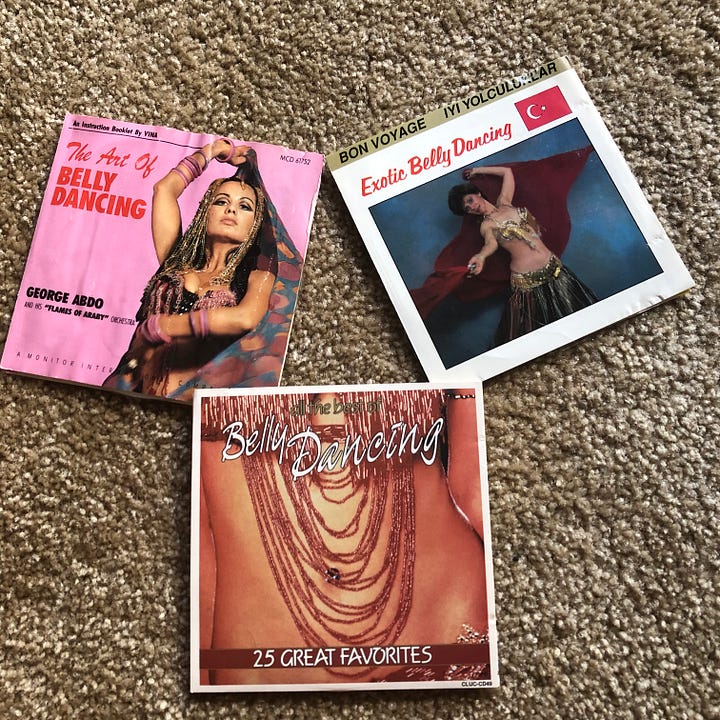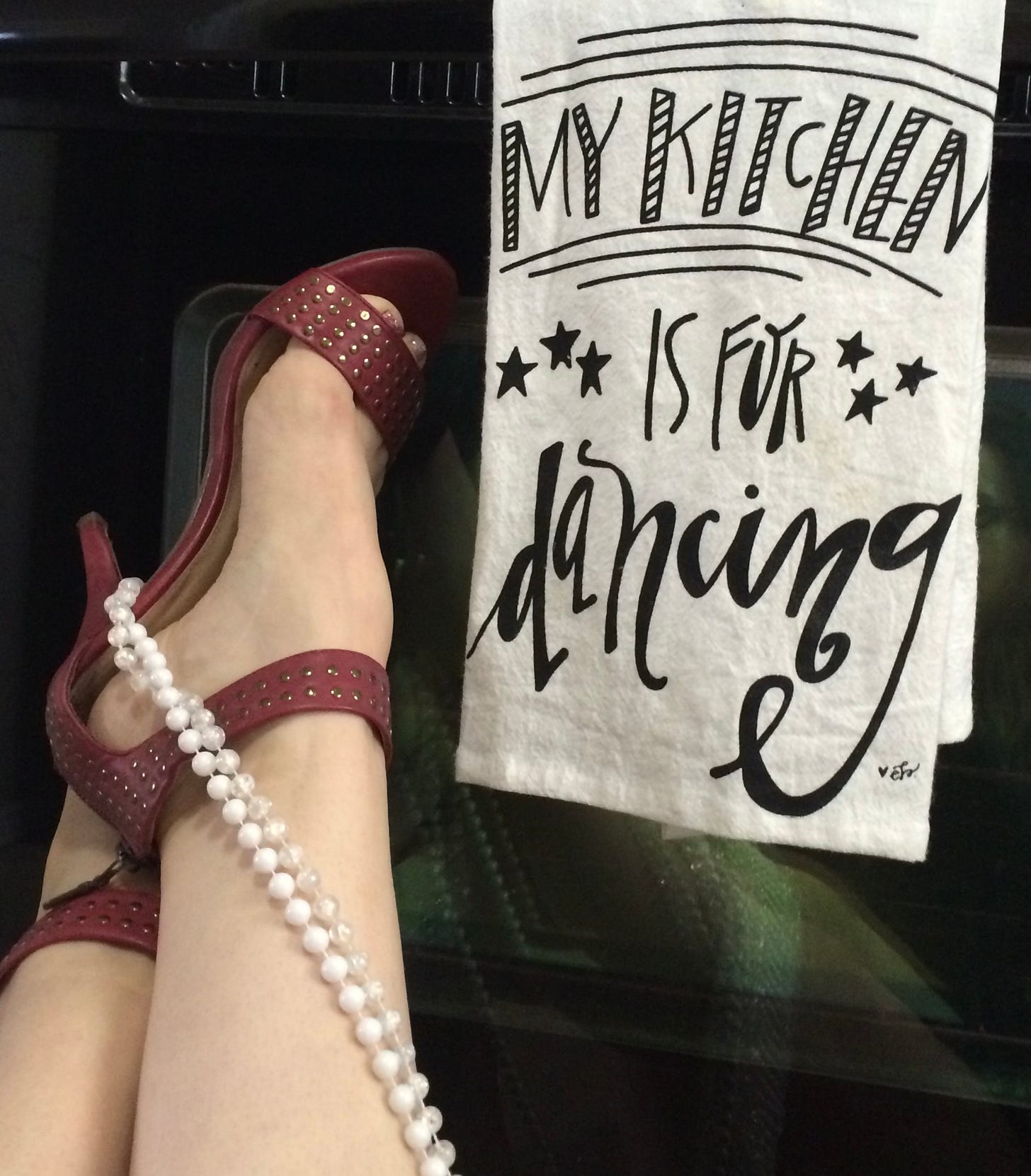…All those attempts to convince people not to study with me or hire me to perform? In the end, it had the opposite effect. This smear campaign and my resulting exile completely broke my dance shackles, setting me free to dance the way I really wanted to. Which gave me my international career.
Because if my detractors thought there was “more Jazz in me” than anything in 2000? Sheeeee-it. They hadn’t seen nothin’ yet. Not from me, and not from the Tribal Belly Dance scene.1
But we can't talk about the Jazz, Swing and Tap Dance that influenced my style without naturally sliding into some touchy topics:
IN SEARCH OF MISSING BLACK MUSES - The shock of learning just how much was missing from my earliest dance education
BEAUTIFUL, SEXY, SILLY, SAVVY - In search of the Shimmy, I discover Flappers & Josephine Baker
CHAIN BREAKER, TREND MAKER, MIND WAKER - Falling in love with La Baker
We’re hip-deep now into the archeological digs2 of my college dance days, searching for the ways in which I filled in the gaping holes of my baby-belly dance instruction when I lost my teacher and had almost no access to legit source materials. That means I had to do what American belly dance enthusiasts have no doubt been doing since this art form crossed the Atlantic (because…you know…that’s kinda what dance and art do…):
Fill in gaps with cross-pollinated moves.
Add in other moves and props from the surrounding dance styles that melded in spectacular fashion and appealed to local audiences.
Evolve differently from dancers in the art form's countries of origin because transatlantic flight was just cutting its teeth, there was no YouTube — there wasn't even VHS, and most Americans wouldn't have had access to intensely study films of the Golden Era belly dancing that were being shot in the "Exotic East". 3
(Not that these are the only belly dance styles going on in the mid-20th Century. They're just the ones copiously captured on film.)
In our current days of YouTube, Google, Zoom, and Amazon, I think we sometimes forget how much harder it once was to find and get ahold of things. To learn things that aren’t commonly taught in our immediate surroundings. Those who grew up with the internet can't have a clue.
Simply trying to find music that wasn't rock, soul, classical, or country in Northern Minnesota of the early 1990s? Bwahahahaha! We had only a tiny World music section, and most of that was of Spanish or Irish influence, not Middle Eastern.
So finding music I could belly dance to was a herculean feat. Finding video footage to study was almost nonexistent. Finding video footage like the clips above?
Impossible.
We had a few Blockbuster Video locations, as well as Waldenbooks, B. Dalton Books, Suncoast Video, Sam Goody, and Tower Records.4 I'm trying to remember if we even had a Walmart yet. If so, it was very new. Instead, we had Target and K-Mart. Yes. Remember K-Mart?
One of our biggest department stores was also Montgomery Ward, if that tells you anything. They definitely had no belly dance anything. It was a bangin’ day when I could find something shiny or metallic to throw into my costuming from Claire’s or JC Penny. But for music, instruction, or monkey-see-monkey-do inspiration?
Besides the small mall, we had one store downtown that sold vinyl, tapes and CDs, new and used, and I scoured that place month after month to ever-mounting frustration. The few items we could order in, we did.
For the first years of my belly dance adventure, this was the extent of my hunted, scoured, unearthed, special-ordered, and prized music collection — BOOM. Three CDs and a cassette tape:


Unfortunately, I didn't even know how to dance to half that stuff, and I was so clueless about this art form that I couldn't figure out why I could never make the moves I'd learned feel right — because two of those albums are full of Turkish music and odd-number rhythms, instead of the symmetrical 4s and 8s I was accustomed to from my first—Lebanese—teacher’s class.5
Only years later, after I was introduced to the Turkish style in Colorado (sooooo much heaven to my body and soul), would I revisit those songs and smack myself on the forehead in comprehension. "Ohhhhh. Now I see. And now I know what to do with these songs I've always loved but could never comfortably dance to."
Feenjon was the album the owners of the Greek restaurant gave me when they first hired me. It was their favorite and they asked me to include it in my performance sets every night.
This was one of the songs I never danced to. I couldn’t grok it because it’s in 9/8. Durrrrr…
But getting my hands and hips on video footage of knowledgeable and skilled dancers I could at least try to mimic like a four-year-old, cymbal-clanging, vacuously grinning wind-up-monkey?
That was not an option.
Even so. I refused to be deterred because I had found one of my life’s all-consuming passions.
LOCAL-YOKEL ANXIOUS-MONKEY GETS A COIN BELT
In my early years of college, the idea of driving down to Minneapolis alone on a wild fringe-chase to study belly dancing terrified me. I was just starting to get comfortable driving in a mid-size town, but I was nowhere near ready to tackle a metropolis I'd only been to a few times on a school bus and in the back seat of a friend's mom's car in elementary school. I remembered what Twin Cities traffic looked like.
😳🫣
Plus, I didn't have extra money for lessons that included gas and trip expenses. I certainly didn't have time to make that a regular thing. My course load was always two-to-five credits past full, and after the spring of my freshman year, I had no idea that I was drowning under the weight of repressed memories from the most violent and abusive relationship I’ve ever been in. I was so screwed up that I changed my major four times and almost dropped out, so tackling Minneapolis to pursue this obsession that countless people tried to steer me away from was not something I could do alone.
But belly dance had literally saved my life,6 so I pursued it any way I could.
Eventually, my discovery of medieval reenactment with its campfire drum circles would give me the in I needed to take on our capital's traffic. First, I bummed rides with others, which allowed me to feel the flow of Minneapolis-St. Paul. That gave me the guts to try it myself.
Eventually, these wondrous, nerdy festival events would also introduce me to the folkloric and blossoming Tribal belly dance styles. But until that discovery in my last years of college, all I could do was play with my toys alone.
So what was a belly dance-obsessed, collegiate-trained theater-and-dance nerd to do after losing her belly dance teacher, when she couldn't find any dance clips like the ones above?
Apparently, something really similar to Suhaila Salimpour, the most famous Californian belly dancer of the day — a dancer I would also discover later and sigh in relief at her Western breakdown of belly dance technique, as well as the East-West blend of moves she combined. That’s when things really started to make conscious sense to me. I would proceeded to kill the VHS tape of her instructional video from watching it so many times.7
Which brings us back to my cross-pollination and fusion hunt.
YET ANOTHER LAYER OF THE SALIMPOUR LEGACY IN ME
Suhaila Salimpour not only has Ballet, Tap and Jazz in her repertoire, but she also studied with a tap dancer who brought the street dances of Oakland Boogaloo to his style. (2) From this collaboration, she honed another distinctive aspect of contemporary Western belly dance — pops, locks, and intricate isolations.
In this same tradition (even though I didn’t realize it at the time), I added what I learned from her to my own studies. This smoothed out my tacked-together seams between the various forms I had used as my crack-fillers. Besides taking Ballet, Modern and Jazz Dance, I also studied Tap, Ballroom, and Swing.
You can see it in the rhythms and structures of the way I often combine shimmies, foot-initiated hip work, and footwork (both percussive and traveling). Like Suhaila, you can also hear it the way I play finger cymbals.
We'll return to those glorious clangers when we get to my medieval reenactment days, because they were a much later addition that I learned around those campfires.
But back in college, I only had my hips and feet for rhythm.
Unless it's a gushy melody that captivates my heart, it always begins with rhythm for me. And that always begins in the feet. Even when I’m standing still, my dancing gets built from the ground-up. That's where I first find the song. That's my in, and everything is constructed on top of that.8
TAP DANCE
As always on this side of the pond, the topic of Tap Dance leads us back to our missing Black muses. I might not have been able to find any of the originating African-American dancers performing the Black Bottom onstage, but in the earliest footage, I was able to find lighter-skinned, male Tap dancers who surreptitiously broke the "two-colored" rule — naturally, only until being outed as Black. Le-heave-of-siiiiiiigh...9
This is the Shim Sham Shimmy by Leonard Reed and Willie Bryant. Watch the way that the footwork leads the hips. It’s subtle here, but it’s part of my foundational makeup:
Now if you watch the difference in hip work between Erin Stevens and Swing Dance legend Frankie Manning,10 you'll start to understand what I took from Tap and exaggerated in my hips, combining it with what I'd learned from my two local belly dance teachers, as well as Madame Lucy, Suhaila Salimpour, Jazz, Mambo, and Funk.
I've never "done it right" in belly dance. Heck, I've never "done it right" in anything. My dastardly belly dance obsession infiltrated my Modern and my Tap; everything else corrupted my belly dancing. This is a big reason why. Because as I was learning to belly dance, I was also learning intricate Jazz isolations, fall-and-recovery, contraction-and-release, and this:
SWING DANCE
As I wrote in the post that kicked off this whole series:
...But my study of dances like the Charleston took place in the early 90s, way before YouTube, and even before Google when I only had email through dialup internet. I learned these dances in cultures dominated by the "quintessential looks" of the 1930s-50s white kids.
Back then, nobody I learned from talked about the controversial roots of these dance forms. They only talked technique and tricks.
But we've definitely got some footage that reminds us of the African-American roots in Swing Dance, as well as showing in glaring clarity the societal roles to which these dancers were still relegated in the 40s — just look at their costumes.
We'll let this video sum up AllTheSentiments for the unacknowledged Black Founders/co-contributors for all the dance forms mentioned in this series of posts and beyond:
Let's actually see the clip she's talking about because these athlete-artist-innovators are too awesome to pass up:
People have always said I was either born to the wrong century, or that I’m ahead of my time. Something I’d been doing for many years that blew people’s minds, got me in trouble, and that was requested of me for multiple shows: combining belly dance with the Swing Dance, Tap, and Jazz that I’ve studied, and fusing it all together to non-belly dance music.
Here's the most overt example of my American footwork making lurve with my belly dancing (2007).
The smartassery is strong with this one…
Okay, I may have done this more than once (2005):
UP NEXT: ORIENTALIST DREAMS: Following in the footsteps of Ruth St. Denis
© 2021 Hartebeast
All my posts about the influences that inspired my dance style can be found in the DanceStory Section of this publication.
The early 2010s - when the Tribal Belly Dance scene fell madly in love with Jazz well before our Roarin’ 2020s hit
The Wikis to scratch surfaces:
Yeeeee! Remember these??? A blast from the past: the mallrat stores that raise the hair on the back of my neck. Hahaha!
How a fringe bra and a coin belt literally saved my life in college. Be warned. This aspect of what made me the dancer I am is over on my NSFW memoir blog, Bella & the Beast.
My discovery of Suhaila Salimpour and the way Jazz Dance influenced my style
The Salimpour Legacy that branched in both the American Cabaret and Tribal Belly Dance directions, and which has roots in both the circus/faire/vaudeville scene and in classical Western training like Ballet, Tap and Jazz Dance.
A dance legend who broke through the "two-color rule" and pushed the bounds of racism further toward the bottomless cliff that it needs to be booted off, Bill "Bojangles" Robinson.
Some stuff Wiki doesn't talk about: Leonard Reed & his tap partner, Willie Bryant
Tap is Timeless - Its evolution and adaptation over the years






